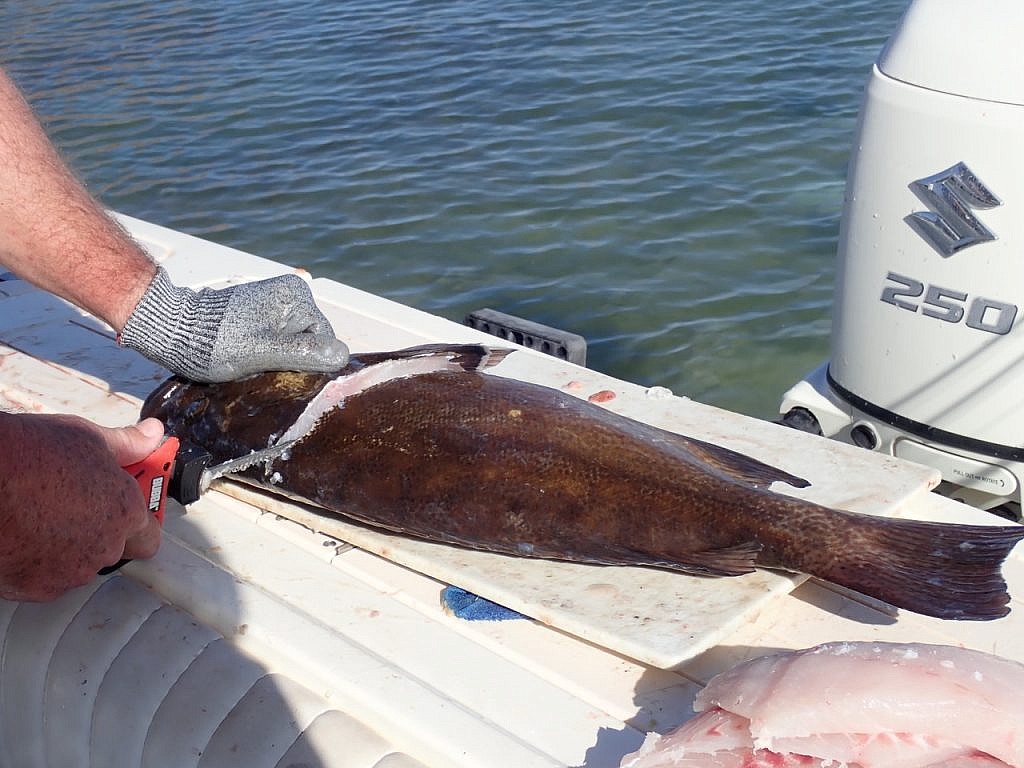
by Scott Sadil
The goldspotted sand bass, Paralabrax auroguttatus, are down about 100, 120 feet. You drop your jig until it hits the reef, feel it stop, then engage the reel and take up a bit of line. Not too much; the fish, a genus-level cousin to the better-known spotted sand bass, barred sand bass, and calico or kelp bass, are tight to the rocks. Twitch the jig and, sure enough, there’s something pulling on your line.
“An underrated species,” says Larry Hansen, head of the Pacific Sportfishing Alliance, as he hoists another goldspot over the gunwale. “Willing biters, they pull hard, and the meat is superb. Guy can load up on fillets and feel good about his trip.”
Now and then I lift a goldspot through the surface, gaze into its bulging eyes, and slip it from the jig hook and drop it back into the water.
How many are we going to kill?
Don’t get me wrong. I love eating fish. But even at a young age, I grew suspicious of any attempts to justify the cost of sport with a load of dead fish. I still recall cutting off my father while we were whacking calicos with lead-headed rubber Scampis cast from rocks on the windward side of Punta Santa Rosalallita. We had a bunch of bass in a gunny sack when he brought another one, spots glowing in the sun, to hand.

“We’ve got plenty,” I said. “Let it go.”
“But it’s a good one,” said my father, holding up the fish for both of us to admire.
“We’ve got more than enough already,” I repeated, a rare display of filial impiety. “And we’ll be fishing again tomorrow.”
Sure, you could place a dollar-and-cents value on a load of fish. But I smelled a rat. Why did we have to justify the cost of our fun and adventure?
And I sensed, even way back then, how much the spirit of all this – what McGuane called “the gunny sack artists of the heavy kill” – how much this kind of bloodshed was tied, inextricably it seemed to me, to some weird need to inflate the ego.

After all, I was a surfer, the objective of which was the brief, elegant, ephemeral dance. A good wave took nothing, produced nothing; the world remained as is – only you, perhaps, a wee bit wiser.
A good fish, released, could be just like that, too.
Still, if you’re going to harvest fish for table fare, says Larry, a veteran of eastern Pacific sportfishing, from Panama to Alaska, you want to do it right. Gone are the days, he says, when you carried home your catch in a gunnysack that had been hanging out on deck in the sun, your fish devolving into something better suited to fertilizing your mother’s heritage roses than serving up as sashimi, sushi, or quick-seared steaks.
According to Larry, here’s how it’s done:
- Immediately upon landing your fish, kill it – best performed by “spiking” it through the brain. A knife or even gaff works; the Japanese iki-jime tool, however, is designed for the job, the aim of which is to both kill the fish and deactivate the central nervous system. Fish that flop around on the deck are bruising themselves, initiating deterioration of the meat.
- Now bleed the fish. Larry uses a pair of sharp, sturdy cutters, the straight blades about three or four inches long. He makes a single deep cut through the back of the gills, forward the pectoral fins, then drops the bleeding fish into water held in the bait tank.
- While the fish bleeds out, Larry goes back to fishing; after an unspecified amount of time, call it 15-30 minutes, he pulls the fish from the water in the bait tank and places it gently in a cooler filled with ice. He buries the fish in ice. Ice is fish meat’s best friend. If you intend to harvest, don’t leave shore without it.
- On the way back to the launch site, Larry stops to fillet his catch. He uses a Bubba Blade electric knife – kind of like a small Sawzall – hooked to one of the boat’s two 12-volt batteries. He’s quick, accurate; flawless fillets pile up as fast as I can load them into gallon freezer bags and set them back on ice.
- For freezer storage, Larry uses a conventional vacuum sealing system, one I didn’t see because we had more immediate plans for our catch. The truth is, I rarely freeze fish. I eat, or share, what’s fresh – and when that’s gone, I have all the more reason to fish some more.
And one more thing. If you’re cooking fish, try not to ruin it. There’s a brief moment when fish meat goes from being uncooked to cooked; if you continue to cook it, it just becomes more and more overcooked, going downhill all the while. Learn the difference. Fish fans will thank you.
Despite killing few fish in any given year, Gray’s Angling Editor Scott Sadil is happy to share in the spoils of anybody’s recent harvest anywhere.
